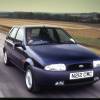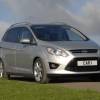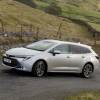
RAC sale – up to 33% off*
• Roadside cover from £5.29 a month†
• We get to most breakdowns in 60 mins or less
• Our patrols fix 4/5 breakdowns on the spot

By Steve Walker
Introduction
By 2008 there weren't too many more common sights on our roads than a Ford Focus. The Blue Oval had sold 1.1 million of its first and second generation models to eager British punters and had bagged more than 80 international awards for the car, including the Car of the Year titles in Europe and North America. That's good going but Ford wanted more from its sharp-handling family hatchback. A series of tweaks was made to keep it fresh and it's the resulting facelifted Focuses we're evaluating here. Is the big-selling, award-winning machine a used car you'd want to own?
Models
Models Covered:
3 & 5dr hatch, 4dr saloon, 5dr estate: 1.4, 1.6, 2.0, 2.5 petrol, 1.6, 1.8, 2.0 turbo diesel [Studio, Style, Zetec, Zetec S, Titanium, ECOnetic, ST, ST2, ST3, RS])
History
When you're on top, everyone tries to shoot you down, be it by looking for chinks in your armour or copying the qualities that got you into that pre-eminent position. That's why getting on top is one thing but staying there is a tougher task altogether. Despite the difficulties involved, Ford's Focus enjoyed an extended reign over the family hatchback segment of the car market that began with the launch of the original model in 1998 and continued when the second generation on arrived in 2005. By that time, the rivals were snapping at its heels so Ford introduced a facelifted model in the interests of keeping them at bay.
What changed? Most notably, Ford introduced the Kenetic design themes that had gone down a storm right across their model range from Mondeo to Focus. The key element of this was the twin trapezoidal grilles that dominated the front end but swept-back headlamps and flared wheelarches also formed an integral part of the look. Ford must have liked it because by 2010, every passenger car model it sold in the UK would exhibit these features in one form or another. There were also changes inside where the Focus had started to feel tangibly less plush than some of its rivals. Soft-touch plastics were introduced, along with higher grade fabrics and redesigned controls.
Three and five-door hatchbacks were available, along with a saloon and an estate but the Focus family also extended to the Coupe-Cabriolet convertible model and the C-MAX compact MPV. The engine line up remained unchanged and expansive: 1.4, 1.6, 1.8 and 2.0-litre normally-aspirated petrol engines were offered, along with the 2.5-litre turbo petrol from the ST and TDCi diesel units of 1.6, 1.8 and 2.0-litre capacities. The 1.6 TDCi engine powered the super-efficient EConetic models, which gained stop/start technology and sub-100g/km CO2 emissions at the end of 2009. Just before this, Ford also introduced the impressive Powershift dual clutch automatic gearbox.
The sporty Zetec S trim level was added to the range late in 2008 and the significantly sportier second generation Focus RS turned up early in 2009 with no fewer than 300 braked horses. The RS500 model was launched in 2010, offering a limited run 345bhp version of the RS for a whopping £35,000.
What You Get
Benefiting from Ford's 'kinetic design' approach to styling, this faclifted MK2 Focus took its inspiration from its larger Mondeo stablemate. Trapezoidal grilles, swept back headlamps, bolder wheel arches, re-shaped rear glass, a contoured tailgate and smarter tail lamps are the key changes. Higher trim grades benefit from chrome detailing and a stylish, body-coloured upper rear spoiler.
Inside, the more upmarket aura continues. Nicer soft-touch plastics cover the dash top as well as the upper front door trim and this is complemented by plusher seat fabrics, plus a variety of more attractive fascia finishes. The instrumentation was re-designed too and, along with other interior controls, is illuminated in red. Controls for the upgraded audio equipment and two-zone air conditioning were ergonomically improved.
The advanced compact control-blade rear suspension on the Focus helps the five-door hatch model achieve a sizable 385-litre carrying capacity, as the load bay is completely flat and unencumbered by suspension intrusion. In the Estate version, there's 475 litres of load space with the 60/40 rear bench in place, but drop the seats and there's a cavernous 1525 litres, making the Focus boot a good deal bigger than those of many executive class estate cars. With the seats in place, the load bay is just over 104cm long, 116cm wide and up to 89cm high. With the rear seats folded you have a 167cm long distance from seat back to tailgate.
Equipment runs to most of what you would expect on a car of this type (twin front airbags, air conditioning, ABS etc) but there are some nice extra touches. In addition to a movable armrest and a four-litre-capacity storage compartment, there are storage areas for back-seat passengers. Plus items such as a 230 volt socket or the USB audio connection box were available with some trim levels.
What You Pay
Please fill in the form here for an exact up-to-date information.
What to Look For
Ford's engines are, on the whole, reliable, so give the car the usual once-over looking for signs of wear and indications of hard fleet, company or rental car use. Worn carpets and scuffed trim are the usual clues. The 1.4-litre engine is a little underpowered for such a substantial car, so avoid high mileage ex-fleeters with this powerplant.
Check that all the electrical items work properly, ensure that the air conditioner delivers chilled air soon after the engine is started and remember that a full service history always helps when selling on, too. If you're looking at ST model, make sure the tyres still have some tread on them, and that the car hasn't been thrashed or crashed. Focuses are tough but some will inevitably have been abused. It is always worth checking the dashboard lights and making sure that all the instruments work. If all the instruments fail, it will be the circuit board that needs replacing. This used to be expensive, but Ford will now provide the replacement for £99.
Replacement Parts
(approx based on a Focus 1.6) This being Ford, parts are plentiful and relatively inexpensive. A clutch assembly will be around £100 and an alternator should be close to £140. Brake pads are around £25 a front set with rear shoes around £45, a replacement headlamp is close to £80 and a manual door mirror should be in the region of £50. A full exhaust is about £200 and a catalyst is about £240. Dampers are around £40 each and a radiator about £100.
On the Road
If driving dynamics are all you care about, this is still the very first car with which you should begin your search for a used family hatchback. The everyday mundanity of the Focus often obscures quite what an incredible car it is. That and the fact that we take this sort of competence for granted.
Ford of Europe ploughed an enormous investment into the first generation Focus and the MK2 model continued to live off the benefits, even though many rivals clawed back much of the ground they lost to the original version of this car. The suspension system is much the same as that used in the 1998 model and the lessons learned in packaging are still as relevant as ever. This sublime handling competency means you can get the most in terms of driving enjoyment from any of the given engines on offer, so drive a Focus before opting for an apparently faster rival: more power doesn't necessarily equal more real world speed. In terms of driving comfort, there are softer-riding rivals, certainly, but you'd be less likely to want to be in one of them on a twisting B-Road.
Overall
It's difficult to go too far wrong with a used Ford Focus, particularly a post-2008 facelift model. Its practicality and interior quality are a match for any rival but the real benefit comes in the way it drives. The engines might be down on power compared to some of the alternatives but the amount of enjoyment it's possible to extract from the finely honed chassis puts the Ford in a class of its own.

![Ford Focus [MK2] [C307] (2008 - 2011) used car review](https://d1ix0byejyn2u7.cloudfront.net/drive/images/made/drive/images/remote/https_d2yv47kjv2gmpz.cloudfront.net/filestore/4/4/1/1_bc1fb944f44451d/4ac7aa743e22f0ba5e2a6d7e4d24a1d8/1144_344cb8801d03d1d_600_400_70.jpg)



![Ford Focus Estate [C519] (2018 - 2021) used car review](https://d1ix0byejyn2u7.cloudfront.net/drive/images/made/drive/images/remote/https_d2yv47kjv2gmpz.cloudfront.net/filestore/0/6/1/1_cb28a37584286cd/8f204e88a1f530dd6abb977d8bcdab0c/1160_45040594fdcf146_100_100_70_c1_c_c.jpg)

